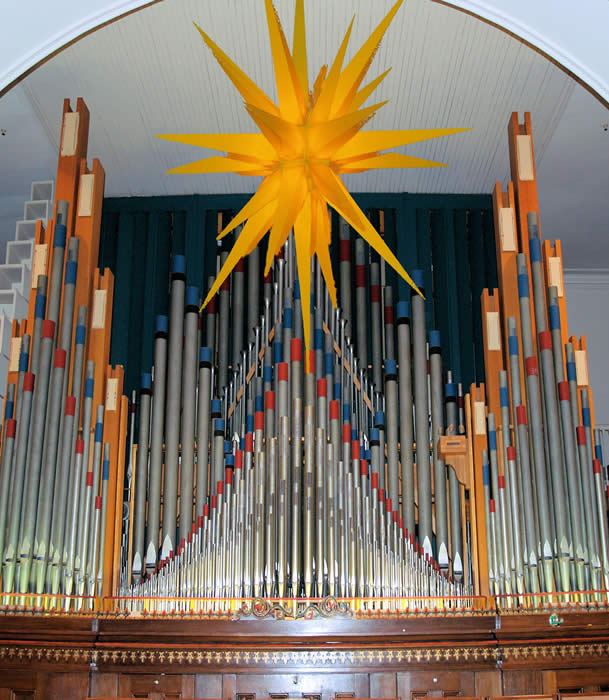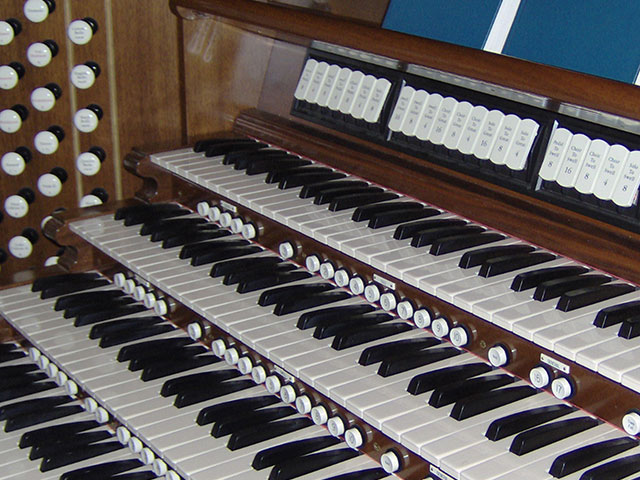| Great | |
|---|---|
| 16' | Quintaton |
| 16' | Flute Conique |
| 8' | Principal |
| 8' | Diapason |
| 8' | Salicional |
| 8' | Gemshorn |
| 8' | Flute Harmonique |
| 8' | Bourdon |
| 4' | Principal |
| 4' | Spitzflöte |
| 2 2/3' | Twelfth |
| 2' | Super Octave |
| Cornet II | |
| Fourniture IV | |
| 16' | Posaune |
| 8' | Trumpet |
| 8' | Liturgical Trumpet |
| Chimes | |
| Swell | |
|---|---|
| 16' | Contra Gamba |
| 16' | Lieblich Gedeckt |
| 8' | Geigen Diapason |
| 8' | Principal |
| 8' | Cello Celeste II |
| 8' | Viole de Gambe |
| 8' | Viole Celeste |
| 8' | Rohr Flute |
| 8' | Flute Celeste II |
| 4' | Principal |
| 4' | Harmonic Flute |
| 4' | Viols II |
| 2 2/3' | Nazard |
| 2' | Flute |
| 1 3/5' | Tierce |
| Plein Jeu IV | |
| 16' | Contra Trumpet |
| 8' | Trumpet |
| 8' | Krummhorn |
| 8' | Oboe d'amour |
| 8' | Waldhorn |
| 8' | Vox Humana |
| 8' | Musette |
| 4' | Schalmei |
| 4' | Clarion |
| Chimes | |
| Solo | |
|---|---|
| 8' | Doppelflöte |
| 8' | Flauto Mirabalis |
| 8' | Orchestral Flute |
| 8' | French Horn |
| 8' | English Horn |
| 8' | Flugelhorn |
| 8' | Corno de Bassetto |
| 8' | Tuba |
| Chimes | |
| Harp | |
| Choir | |
|---|---|
| 16' | Violone |
| 8' | Viola |
| 8' | Viola Celeste II |
| 8' | Diapason |
| 8' | Gemshorn Celeste II |
| 8' | Gedeckt |
| 8' | Erzahler |
| 8' | Erzahler Celeste |
| 4' | Principal |
| 4' | Nachthorn |
| 4' | Gemshorn Celeste II |
| 2 2/3' | Nasat |
| 2' | Octav |
| 2' | Blockflöte |
| 1 3/5' | Tierce |
| 1' | Sifflote |
| Mixture III | |
| Mixutre IV | |
| 16' | Fagot |
| 16' | Bassoon (Pedal) |
| 8' | Liturgical Trumpet (Gt) |
| 8' | Petit Trumpet |
| 8' | Clarinet |
| 8' | Orchestral Oboe |
| 8' | Bassoon |
| 4' | Trompette |
| Chimes | |
| Celesta | |
| Orchestral Harp | |
| Pedal | |
|---|---|
| 32' | Grand Bourdon |
| 32' | Untersatz |
| 32' | Violone |
| 16' | Contre Bass |
| 16' | Diapason |
| 16' | Bourdon |
| 16' | Gedeckt |
| 16' | Contre Gamba (Sw) |
| 16' | Lieblich Gedeckt (Sw) |
| 16' | Flute Conique |
| 16' | Flute Conique Celeste |
| 8' | Octave |
| 8' | Bourdon |
| 8' | Flute |
| 8' | Gamba (Sw) |
| 5 1/3' | Quint |
| 4' | Super Octave |
| 4' | Bourdon |
| 4' | Nachthorn (Ch) |
| 2 2/3' | Quint |
| 2' | Octavin |
| Grand Mixture IV | |
| 32' | Bassoon |
| 32' | Contra Bombarde |
| 16' | Bassoon |
| 16' | Trombone |
| 16' | Contra Trumpet |
| 8' | Bassoon |
| 8' | Trumpet |
| 4' | Bassoon |
| 4' | Clairon |
| Tower Chimes | |
Notes
Digital voices in italics.
When David Tannenberg, famous eighteenth century Moravian organ-builder, saw the plans for this church, he asked that the ceiling be raised by four feet to accommodate the large pipes of the organ he had been commissioned to build. This was to be his (magnum opus), his crowning achievement, but he fell from a ladder and died before he could start work on it. Thus the first organ in Central Church was built by the New York firm of John Geib and Sons. It was played for the dedication of this church, May 18, 1806, by John Frederick Peter, the most talented of the early Moravian musicians and composers (In 1811, what may have been the first rendition in America of Haydn's Creation, was presented in Central Church under Peter's direction— accompanied by organ and orchestra.)
In 1873, the Geib organ was moved from the church to the chapel of the Moravian Preperatory School and replaced by a larger one, built by Jardine and Son, also of New York. This was a magnificent instrument, the organ of J. Fred Wolle when he organized the Bethlehem Bach Choir. The first Bach Festivals were held in this church. The old Geib Organ was not kept in usable condition and was carried off, pipe by pipe, by the students of the Preparatory School. More is the pity, because not even one Geib built organ is known to exist today.
In 1910, the Jardine organ was renovated and electrified by the M. P. Moeller Company of Hagerstown, Maryland, and served acceptably until it was severely damaged by fire in 1941. The question then was whether to rebuild it or purchase a new one. Because materials were getting scarce, due to World War II, then in progress, the necessary repairs were made.
In 1950, a new electro-pneumatic Moeller Pipe organ was installed. When the committee appointed to procure a new organ had agreed on its specifications, it was discovered that the cost would exceed the $45,000 limit set by the congregation. To stay within this limit, four stops were omitted, though preparation was made for their eventual installation. They were added in 1957 as a memorial to Miriam Marsteller Snyder (1904–1955) by her husband, Harold B. Snyder.
A "Carillon Americana." consisting of four sets of Schulmerich electronic bells (English, Harp, Quadra and Celesta), was dedicated on January 10, 1960 as a memorial to Dorothy Fry Honeycutt (1890-1958). Given by her husband, Jesse V. Honeycutt, these bells are an integral part of the organ, are played only from the organ console and are heard only in the sanctuary, never from the church belfry. Their tones are not "manufactured," but are made by striking actual bell metal with a steel hammer, then amplified.
In 1961, also through the generosity of Jesse V. Honeycutt, a new rank known as the Liturgical Trumpet was added, increasing the total number of stops to 54. The organ as it now stands has 3057 pipes, arranged in 48 ranks. It has four divisions, namely Great, Swell, Choir and Pedal, played from three manuals, plus the foot pedals.
This Moeller organ was designed and voiced by Ernest White, who at that time was an employee of the Moeller Pipe Organ Company. The late president of the Moeller Company, a son of the founder, is reported to have said that this is the best (though not the largest) organ his company has ever built. Designed especially for Central Church, its tones are bright and clear. Another of its outstanding features is its versatility.
In 2007 the organ was restored by Emery Brothers with added digital enhancements by the Walker Technical Company.

